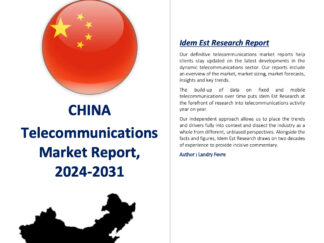Your cart is currently empty!
Myanmar Telecoms Industry Report – 2024-2031
The second edition of this report provides analyses of revenue and market forecasts as well as statistics of the Myanmar telecoms industry including market sizing, 5-year forecasts, market insights, key telecom trends, 5G and also features the following: Overall Telecommunications Market by Major Operators Telco Operators Profile, Revenue and EBITDA Mix Mobile Subscribers & Revenue Market Overview and Forecasts Spectrum Holdings IoT Market Overview Telecoms Infrastructure Review: Towers, backbone fibre, submarine cables & data centres Broadband Subscribers & Revenue Market Overview and Forecasts National Broadband Network Detailed Market Overview and Forecasts Thematics / Opportunities relating to 5G, M&A and e-Commerce…
Description
WHY YOU SHOULD BUY THE MYANMAR TELECOMS INDUSTRY REPORT:
- Benefit from the latest market opportunities
- Understand the threats to your operations and investments and protect your company against future risks
- Gain insights on emerging trends supporting, enhancing or disrupting your activities in the market
- Get a full view of the competitive landscape to assess your market position.
- Forecasts as a key input for successful budgeting and strategic business planning in the telecoms market
- Target business opportunities and risks in the telecoms sector through our reviews of latest industry trends, regulatory changes and major deals, projects and investments
- Assess the activities, strategy and market position of your competitors, partners and clients via our Operators Profiles
The Myanmar Telecommunications Industry Report, 2024-2031 includes a comprehensive review of the Burmese market dynamics, market sizing, market forecasts, analysis, insights and key trends.
EXECUTIVE SUMMARY
Myanmar Telecoms Industry Report at a Glance
Key Developments in Myanmar’s Telecom Industry:
•Military Coup Impacting Foreign Investment: The 2021 coup led to significant reductions in foreign direct investment (FDI) due to political instability.
•New 15% Internet Tax: A 15% tax on both mobile and fixed internet data was introduced, impacting service costs for consumers.
•Telenor’s Exit: In 2022, Telenor exited the Myanmar market, with Lebanon-based M1 Group and local conglomerate Shwe Byain Phyu taking over operations.
•Ooredoo’s Exit: In 2023, Ooredoo left the market, with its operations acquired by Singapore-based Nine Communications and Thailand’s Link Group.
•Slowdown in Infrastructure Rollout: The rollout of mobile towers and telecom infrastructure has slowed, especially with Mytel, due to its close ties with the junta government.
•Stable Industry Outlook Amid Uncertainty: Despite political challenges, Idem Est Research expects the Myanmar telecom industry to remain relatively steady, driven by the essential nature of telecommunications, even with limited foreign investment and economic sanctions.
Myanmar’s Telecom Market Outlook:
Myanmar was once one of the fastest-growing telecom markets globally, driven by investments since 2014. However, following the coup, Myanmar is now viewed as one of the world’s most repressive countries in terms of telecommunications. The political instability is undermining earlier reforms that had significantly boosted the economy and quality of life.
Despite these challenges, Idem Est Research projects that Myanmar’s telecom market will grow at an average annual rate of 2.7% by 2031. While this growth is modest, the sector has shown resilience in the face of political and economic headwinds.
Mobile Market Growth:
The report highlights that Myanmar’s mobile market, although still expanding, will grow at a slower pace. Mobile subscriptions are forecasted to grow at a 2.7% compound annual growth rate (CAGR) through 2031, down from the 6.3% CAGR seen between 2017 and 2023. This slower growth is partly due to the decline in mobile subscriptions following the introduction of strict SIM registration requirements in 2021 and 2022.
Fixed Broadband Growth:
The fixed broadband market in Myanmar remains underdeveloped, with household penetration at just 6.6% in 2023. However, investments in fiber-to-the-home (FTTH) infrastructure by companies like MPT, Ocean Wave, and 5BB Broadband are expected to drive significant growth, with subscriptions projected to rise by 17% annually through 2031.
Tower Infrastructure and Investments:
As of 2023, independent tower companies own 56% of Myanmar’s mobile towers. Major players include Irrawaddy Green Towers, edotco, Apollo Towers, and Pan Asia. The report forecasts a modest 1.5% growth in mobile towers through 2031, but revenue per tower is expected to decline as operators focus on smaller, lower-revenue sites.
Barriers to Telecom Growth:
The 2021 coup severely impacted Myanmar’s potential as an exciting emerging telecom market. Foreign direct investment has slowed, rural network rollouts are limited, and the country’s telecom infrastructure lags behind other Southeast Asian nations. Nevertheless, Myanmar’s long-term growth potential remains substantial if political conditions improve.
Capex Investments:
Capital expenditure (Capex) in the telecom sector surged after Ooredoo and Telenor entered the market in 2014. However, since 2021, Capex spending has plummeted, and Idem Est Research expects it to remain stable but lower than in previous years. Investments in fixed broadband are starting to emerge as operators focus on profitability in an increasingly competitive environment.
Operator Profiles:
Myanmar’s telecom market is dominated by four major mobile operators: Myanmar Post Telecommunications (MPT), Atom Myanmar (formerly Telenor), Ooredoo Myanmar, and Mytel. Competition is fierce, with over 95% 4G population coverage achieved. Operators are now diversifying their services into FTTH and e-commerce to drive further growth.
Mobile and Broadband Market Dynamics:
Between 2014 and 2021, MPT lost market share to Atom and Ooredoo. While Mytel initially captured market share with its rapid growth, its close ties to the junta have negatively impacted its reputation, and it has lost ground in recent years.
Mobile revenue growth has slowed compared to subscription growth due to declining voice and SMS revenues. Data monetisation remains a challenge, with operators resorting to bundling and discounts to retain customers. According to the report, Myanmar’s mobile data pricing remains among the highest in Southeast Asia, despite significant reductions in cost per GB in recent years.
Fixed Broadband – The Next Frontier:
Myanmar’s fixed broadband market is still in its early stages, but FTTH deployments are gradually expanding, especially in urban areas. Private operators such as 5BB Broadband, YTP, and MyanmarNet have invested in FTTH infrastructure, while MPT is leading the charge with its Dome Pyan Fiber Internet product, covering 64 out of 351 townships.
Telecom Infrastructure and 5G:
Infrastructure funds and investors are assigning high valuations to telecom infrastructure assets like mobile towers, data centers, and fiber networks. The arrival of 5G is expected to transform the telecom industry further, though its full potential in Myanmar remains uncertain due to investment challenges and business model uncertainties.
Conclusion:
Myanmar’s telecom market faces significant obstacles, but its long-term potential remains intact. As the country continues to expand its mobile and fixed broadband infrastructure, opportunities for growth in both segments remain high. However, political stability and increased foreign investment will be crucial to unlocking the market’s full potential.
Idem Est Research’s Myanmar Telecom Industry Report provides in-depth insights into the challenges and opportunities facing operators, infrastructure providers, and investors in this dynamic and complex market.
KEY COMPANIES MENTIONED IN THIS MYANMAR TELECOMS INDUSTRY REPORT:
5BB Broadband (Global Net), Atom Myanmar, Hyalroute (MFOCN), Internet Maekhong Network, Irrawaddy Green Tower (IGT), MM Link, Myanmar Country, Myanmar Post & Telecommunications (MPT), MyanmarNet, Mytel, Nine Communications, Ocean Wave, Ooredoo Myanmar, Unilink, YTP
Myanmar Telecoms Industry Report – Table of Contents
1 Key Statistics
1.1 Myanmar’s Population & Households
1.2 2021 Military Coup
1.3 Myanmar’s Economy
1.4 Myanmar’s GDP
2 Overall Telecommunications Market, 2017–2031
2.1 Market Overview
2.2 Historical Telecommunications Market Revenue, 2017-2023
2.3 Overall Telecommunications Market Forecast, 2023-2031
2.4 Telecommunications Market Capital Expenditure, 2017-2031
2.4.1 Historical Telecommunications Capex Spend, 2017-2023
2.4.2 Capex to Revenue Benchmark
2.4.3 Capex to GDP Benchmark
2.4.4 Telecommunications Capex Spend Forecast, 2000-2031
3 Telecommunications Operators Profile
3.1 Myanmar Post and Telecommunications Profile
3.1.1 MPT Revenue and EBITDA Mix
3.2 Atom Myanmar
3.2.1 Atom Myanmar Revenue and EBITDA Mix
3.3 Ooredoo Myanmar Profile
3.3.1 Ooredoo Myanmar Revenue and EBITDA Mix
3.4 MyTel
3.4.1 Mytel Revenue and EBITDA Mix
3.5 Other Players Profile
3.5.1 Yatanarpon Teleport
3.5.2 5BB Broadband
3.5.3 Other Broadband Providers
4 Mobile Market
4.1 Mobile Subscribers Historical and Forecast, 2017-2031
4.1.1 Mobile Subscribers Historical, 2017-2024
4.1.2 Mobile Subscribers Market Share, 2017-2024
4.1.3 Myanmar Smartphone Share, 2024
4.1.4 Myanmar Mobile Subscribers Forecast, 2023-2031
4.1.5 Myanmar Mobile Subscribers by Generation Forecast, 2023-2031
4.2 Mobile Revenue Historical and Forecast, 2017-2031
4.2.1 Historical Mobile Revenue, 2017-2023
4.2.1 Mobile Revenue Market Share, 2017-2023
4.2.2 Mobile Revenue Forecast, 2023–2031
4.2.3 Mobile Subscribers ARPU, 2017-2023
4.3 Spectrum Holdings
4.3.1 Existing Spectrum Holdings and 5G Trials
4.3.2 Mobile Frequencies Portfolios Analysis
4.3.1 Spectrum Depth Benchmark by Country
4.4 Mobile Download Data and Pricing Trends
4.5 Mobile Speed Tests
4.5.1 Ookla Mobile Speed Tests
4.5.2 OpenSignal
4.6 Internet of Things (IoT)
5 Broadband Market
5.1 Fixed Broadband Subscribers Historical, 2017-2023
5.2 Fixed Broadband Subscribers Forecast, 2023-2031
6 Fixed Telecommunications Infrastructure Investments
6.1 Fixed Digital Infrastructure
6.1.1 Domestic Fibre Infrastructure
6.1.2 FTTH – 6m premises to go
6.2 Submarine Cables
7 Myanmar Telecom Towers Market Analysis, 2024
7.1 Myanmar Telecom Towers Market Overview
7.2 Myanmar Telecom Towers Background
7.3 4G Mobile Coverage Expansion
7.4 Myanmar Mobile Tower Infrastructure
7.4.1 Myanmar Tower Market Competitive Landscape Comparison
7.5 Myanmar Telecom Towers & rooftops Market Forecast
7.5.1 Myanmar Telecom Towers Forecast 2023-2031
7.5.2 Regulatory Considerations
7.6 Myanmar Economic Cooperation Profile
7.6.1 Myanmar Economic Cooperation Key Performance Indicators
7.7 Irrawaddy Green Towers Profile
7.7.1 Irrawaddy Green Towers Key Performance Indicators
7.8 Eco Friendly Tower Profile
7.8.1 Eco Friendly Tower Key Performance Indicators
7.9 AP towers Profile
7.9.1 AP Towers Key Performance Indicators
7.10 edotco Profile
7.10.1 edotco Towers Key Performance Indicators
7.11 OCK Profile
7.11.1 OCK Key Performance Indicators
7.11.2 Tower Density Benchmark
7.12 Telco Infrastructure Comparative
8 Thematics / Opportunities
8.1 Consolidation Opportunities
8.2 Diversification Opportunities
8.3 New Telecoms Operating Model
8.3.1 The Attraction of Infrastructure Multiples
8.4 6G Developments
9 Telco Transaction Database
10 Methodology
11 Copyright Notice
Myanmar Telecoms Industry Report – List of Figures
Figure 1 – Telco sector revenue as % of GDP in Myanmar
Figure 2 –Revenue Profile Historical Mix (MMK bn), 2017 – 2023
Figure 3 – Telecommunications Market Revenue, 2023
Figure 4 – Telecommunications Market EBITDA, 2022
Figure 5 – Telecommunications Revenue & EBITDA Share, 2023
Figure 6 – Total Telecoms Market Revenue and Growth Rate (MMK bn), 2023-2031
Figure 7 – Capex to Revenue Benchmark, 2017-2023
Figure 8 – Capex to GDP Ratio Benchmark, 2017-2023
Figure 9 – Telecommunications Capital & Operational Expenditure Spend, 2000-2031
Figure 10 – MPT Revenue Mix – 2017-2023
Figure 11 – Mobile Subscribers Share Comparison, 2017-2024
Figure 12 – Mobile Subscriber Share Comparison, 2017-2023
Figure 13 – Mobile Net Adds (000’s) Comparison, 2017-2024
Figure 14 – Mobile Subscribers Forecast, 2023-2031
Figure 15 – Mobile Subscribers by Generation Forecast, 2023-2031
Figure 16 – Mobile Revenue Share Comparison, 2017-2023
Figure 17 – Mobile Revenue Forecast, 2023-2031
Figure 18 – Mobile Subscribers ARPU, 2017-2031
Figure 19 – Subscriptions per MHz of Spectrum, Select Asia-Pacific Countries, 2024
Figure 20 –Mobile Handsets Monthly Download Data, 2017-2023
Figure 21 – Data Pricing Trends in Asia Pacific (USD per GB per Month), 2017-2023
Figure 22 – Asia Pacific Data Pricing Benchmark, 2024
Figure 23 – Spectrum available for IoT in Myanmar
Figure 24 – Broadband Subscribers Share Comparison, 2017-2023
Figure 25 – Myanmar Net-Adds (000’s) by Operators, 2017-2023
Figure 26 – Broadband Subscribers Forecast, 2023-2031
Figure 27 – Myanmar Mobile Towers Market Share, 2024
Figure 28 – Myanmar – Base Station Transceiver Rollout by Operators and by Generation, 2023
Figure 29 – Myanmar Telecom Towers Forecast, 2023-2031
Figure 30 – Subscribers per Tower, 2023
Figure 31 – Telecoms Providers EV/EBITDA Ranges
Myanmar Telecoms Industry Report – List of Tables
Table 1 – Myanmar – Key Statistics
Table 2 – Telecommunications Market Revenue by Operators, 2017-23
Table 3 – Total Telecommunications Market Revenue, 2023-2031
Table 4 – Historical Telecommunications Capex Spend, 2017-2023
Table 5 – Total Telecommunications Capex Investments Forecast, 2023-2031
Table 6 – Historical MPT Revenue & EBITDA, 2017-2023
Table 7 – Atom Myanmar Revenue and EBITDA Mix, 2017-2023
Table 8 – Ooredoo Myanmar Revenue and EBITDA Mix, 2017-2023
Table 9 – Mytel Revenue and EBITDA Mix, 2017-2023
Table 10 – Historical Mobile Subscribers, 2017-2023
Table 11 – Myanmar Mobile Subscribers Forecast, 2023-2031
Table 12 – Myanmar Mobile Subscribers by Generation (2G, 3G, 4G & 5G) Forecast, 2023-2031
Table 13 – Historical Mobile Service Revenue, 2017-2023
Table 14 – Mobile Service Revenue Forecast, 2023-2031
Table 15 – Historical Mobile ARPU, 2017-2023
Table 16 – Spectrum Holdings by Operators and by Bands (MHz)
Table 17 – Mobile Frequencies by Operators and by Band (MHz)
Table 18 – Historical Broadband Subscribers, 2017-2023
Table 19 – Backbone Fibre Routes and Length, 2019
Table 20 – International Submarine Cable Systems with Landing Stations in Myanmar
Table 21 – Myanmar Telecom Towers Market Analysis, 2024
Table 22 – Myanmar Tenant Indicative Tower Leasing Monthly Fees
Table 23 –Base Station Transceiver Count by Operator and Generation, 2023
Table 24 – Myanmar Tower Market Competitive Landscape Comparison
Table 25 – Myanmar Telecom Towers, Revenue, Mobile Subscribers, Penetration & ARPU Forecast, 2023-2031
Table 26 – Myanmar Economic Cooperation Key Performance Indicators, 2023
Table 27 – Irrawaddy Green Towers Key Performance Indicators, 2023
Table 28 – Eco Friendly Key Performance Indicators, 2023
Table 29 – AP Towers Key Performance Indicators, 2023
Table 30 – edotco Key Performance Indicators, 2023
Table 31 – OCK Key Performance Indicators, 2023
Table 32 – MPT, Atom, Ooredoo, Mytel and MOFCN Telco Infrastructure Landscape
Table 33 – Telco Transaction Database, 2014-2024
Other Idem Est Research Telecoms Country Reports
Australia, Bangladesh, China, India, Indonesia, Japan, New Zealand, Malaysia, Myanmar, Pakistan, Philippines, Singapore, South Korea, Taiwan, Thailand, Vietnam,
Asia Pacific Telecom Towers, Asia Pacific Satellite Internet, Starlink Company Profile
Additional information
| Brand | Idem Est Research |
|---|
Related products
-
Asia Pacific Satellite Internet Market Report, 2025-2032
AUD1,764.00 – AUD5,888.00 -
Asia Pacific Telecom Towers Market Report – 2020-2027
AUD4,888.00 -
Australia Telecoms Industry Report – 2025-2032
AUD2,188.00 -
Bangladesh Telecoms Industry Report – 2024-2031
AUD2,188.00 -
China Telecoms Industry Report – 2024-2031
AUD2,188.00






